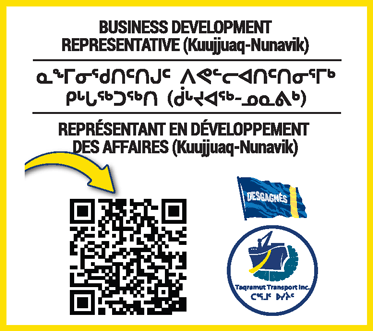Beads, bones and cairns: Gjoa Haven resident shares local history
Ex-Hudson’s Bay Co. manager recalls hamlet’s history from recovering artifacts to Nunavut’s creation
Rick Dwyer, a Scottish ex-Hudson’s Bay Co. manager who has lived in Gjoa Haven for nearly 50 years, holds a photo of Qijuktakvik, a deep granite crevasse near the Back River rapids, in his home on June 9. Known locally as “the place to gather heather,” the site may have been used as shelter by Franklin expedition members, though that remains uncertain. (Photo by Nehaa Bimal)
Rick Dwyer has lived in Gjoa Haven for nearly half a century.
The 76-year-old former Hudson’s Bay Co. manager and British Army veteran arrived in the Arctic from Scotland in the 1970s and never left.
He married into an Inuit family in Gjoa Haven and remembers the stories they shared, many related to the ill-fated 1845 Franklin expedition. Two ships and their crews were lost for more than a century after searching for the Northwest Passage.
“When I got together with my late wife, Martha Tululik, in 1973, her sisters had these beads,” Dwyer said. “My wife said, ‘We used to dig for beads at our camp down at the Back River rapids in the summer.’ I said, ‘What do you mean, you used to dig for beads?’”
Turns out, the beads weren’t just colourful pebbles.
Dwyer said they were beads made in Venice around 1820 and used for trading, possibly left behind by British explorer George Back’s 1833 expedition to search for John Ross and his crew, who went missing on their second expedition to find the Northwest Passage. (Ross’s ship was crushed in the ice, but he was eventually rescued by whalers and returned to Britain where he was knighted).
Dwyer was also at the centre of another mystery — the so-called Amundsen box, long believed to contain relics from Norwegian explorer Roald Amundsen’s time in Gjoa Haven in the very early 1900s.
The tip that it might exist came from Gjoa Haven resident George Porter Sr., who had also worked for the Hudson’s Bay Co.
“[He] had told me that below the Amundsen cairn [erected by Amundsen in 1912], about two or three feet deep, is a wooden box with a narrow metal container,” said Dwyer.
“Inside is a picture that Amundsen left behind of a man called Neumayer.”
With permission from the Nunavut government, Dwyer helped dig up the box.
“[The photograph] was so wet, so I had to press it down under towels and a mattress. And in two days it was bone dry,” he said.
The photograph showed Dr. Georg von Neumayer, a German geophysicist who taught Amundsen about polar navigation and magnetic variation.
Amundsen reportedly left it with instructions: “Whoever finds this photograph is requested to leave it there,” said Dwyer.
“What I didn’t want is someone digging it up and trying to sell it, so instead it’s with the Yellowknife [Historical] Museum.”
Other artifacts he and his wife found include an old musket with its barrel cut away, and a wooden knife authenticated as made in England in 1820. These were discovered in Starvation Cove, where Franklin’s crew perished.
Dwyer’s stories predate the creation of Nunavut in 1999.
He remembers early Gjoa Haven, including a visit from Stuart Hodgson, the Northwest Territories’ first resident commissioner.
Hodgson was speaking to local people, asking whether they wanted to continue living on the land or settle permanently in town. Dwyer’s wife helped to interpret.

Rick Dwyer holds Venetian trade beads believed to date back to around 1820, possibly left behind by George Back’s 1833 Arctic expedition. Also shown are remnants of soapstone pipes and figurine found near a 15-metre deep crevasse west of the Back River rapids. (Photo by Nehaa Bimal)
“What I was surprised to hear was that most old people said they didn’t want to go back and live on the land,” Dwyer said.
“My father-in-law stood up and said, ‘I don’t want to go back to the land. Here in Gjoa Haven, we have a store, we have a school. Without these, life is hard.’”
Some hoped the town would grow. Others spoke about southern medical care they’d received.
“My wife and her parents used to say, if you hear anybody say we were forced from the land, it’s all lies,” Dwyer said. “Those people have never suffered from starvation.”
Dwyer also recalled the day in 1999 when the vote to create the territory of Nunavut was held.
“I went to the community hall in Gjoa Haven when the vote for Nunavut happened, and about 70 people told me their names weren’t on the list. They were really annoyed,” he said.
Though he doesn’t remember who he called when he went to the hamlet office, he remembers the response.
“Whoever it was on the phone said they’d get somebody on it right away, but the vote was to happen in two days. We never heard about it after that.”
Dwyer’s stories of the Back River beads are included in the 2008 book Encounters on the Passage: Inuit Meet the Explorers, written by Dorothy Harley Eber.
“If I was a writer describing these [stories] I’d say, ‘as far as we know,’” Dwyer said.






That’s a very interesting take on relocating to settlements from this man’s late wife and her family. Of course, that’s her subjective experience and may not accord with broader experiences.
Having read the works of early explorers it’s not surprising at all. In fact I would be surprised if they wanted to stay on the land, at least from those reports.
No wonder the Porter family found nothing when they dug up the cairn a few years ago. Why did no one in gjoa haven knew he dug up these artifacts? and why did he bring them to yellowknife this makes no sense they should be in gjoa haven what else did he dig up? Did he make a lot of money of these artifacts?
What a ridiculous reply to my story !
When I went to old George Porters house he told me to tell the HBC and GNWT about the
Amundsen cairn. A lot of his children and grandchildren were there. He was afraid it would
be vandalized or destroyed. The photo that is.
Many people came to see the photograph and were happy about it.
I never went to Yellowknife with the photo, it was the HBC district manager
The other relics were from my wife’s family,
No Uqshuqtuuq, I never received any money at all.
These are sentimental things not worth any money at all
Why did some of the Porter family dig up the cairn site at all ?
Many of them knew about the story as I have told it.
So ask you Uqshuqtuuq what did the Porter family find recently, did they make money ?
I saw this photograph a few years ago when I was on vacations from Norway.
The museum staff were grateful to George Porter Sr. and to Rik Dwyer for getting the
photo to a place of safety in Yellowknife.
They said it would have wasted away if those HBC employees had done nothing about it.
The photo is of G. Neumayer, it is not R Amundsen.
I
What gave the Porter family the impression that any found artifacts belongs to them in the first place? What makes you feel so entitled? What a relief to know YOU didn’t obtain anything otherwise you would have sold them since that seems to be your concern. Time for you to sit down and realize you’re noone special
Uqshuqtuuq, when I was a nurse in Kitikmeot, I heard that two men from Gjoa Haven had
been to Ottowa to do with this photograph and that was all I heard.
Some people seemed to think they received money and never told anyone.
I only saw this arcticle yesterday.
Intriguing stories indeed with the era of precontact times gradually transitioning & with the introduction into modern life.